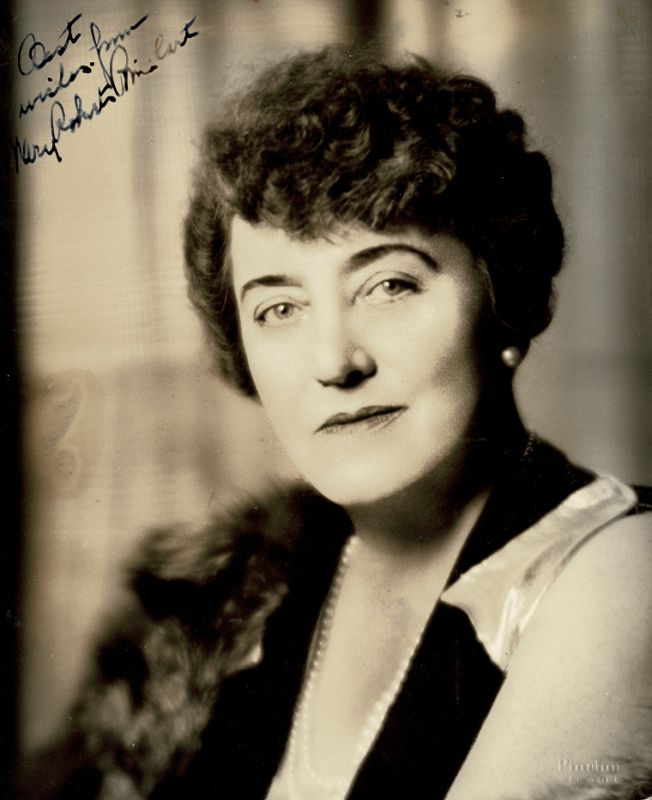Rinehart, Original Portrait Photograph Signed by the "Amerian Agatha Christie",
Original Portrait Photograph Signed by the “Amerian Agatha Christie”, Mary Roberts Rinehart.
[USA], c.1915. Quarto (19.5 cm wide xo 24.3 cm high). 1 sheet. Very good condition with only minor signs of wear.
Mary Roberts Rinehart (August 12, 1876 – September 22, 1958) was an American writer, often called the American Agatha Christie. Rinehart published her first mystery novel, The Circular Staircase, in 1908, which introduced the “had I but known” narrative style. Rinehart is also considered the earliest known source of the phrase “the butler did it”, in her novel The Door (1930), although the exact phrase does not appear in her work and the plot device had been used prior to that time. She also worked to tell the stories and experiences of front line soldiers during World War I, one of the first women to travel to the Belgian front lines.
Rinehart wrote hundreds of short stories, poems, travelogues and articles. Many of her short stories, books, and plays were adapted for movies, such as Bab: A Sub-Deb (1917), The Bat (1926), The Bat Whispers (1930), Miss Pinkerton (1932), and The Bat (1959 remake). The novel The Circular Staircase was first adapted to the screen as a silent film in 1915, and later as an episode in the TV show Climax! in 1956. In 1933 RCA Victor released The Bat as one of the early talking book recordings. She co-wrote the 1920 play The Bat which was later adapted into the 1930 film The Bat Whispers. The latter influenced Bob Kane in the creation of Batman’s iconography.
Carole Lombard and Gary Cooper starred in I Take This Woman (1931), an early sound film based on Rinehart’s novel Lost Ecstasy (1927).
While many of her books were best sellers, critics were most appreciative of her murder mysteries. Rinehart, in The Circular Staircase (1908), is credited with inventing the “Had-I-but-Known” school of mystery writing. The Had-I-But-Known mystery novel is one where the principal character (frequently female) does things in connection with a crime that have the effect of prolonging the action of the novel. In The Circular Staircase “a middle-aged spinster is persuaded by her niece and nephew to rent a country house for the summer. The gentle, peace-loving trio is plunged into a series of crimes solved with the help of the aunt.” Ogden Nash parodied the school in his poem Don’t Guess Let Me Tell You: “Sometimes the Had I But Known then what I know now I could have saved at least three lives by revealing to the Inspector the conversation I heard through that fortuitous hole in the floor.″
The phrase “The butler did it” is often attributed to Rinehart’s novel The Door, in which the butler actually did murder someone, although that exact phrase does not appear in the work. The device had been used earlier (for example Herbert Jenkins’ 1921 story “The Strange Case of Mr. Challoner”) to the point that in 1928 S.S. Van Dine wrote a critique of mystery novels called “Twenty Rules for Writing Detective Stories” in which he argued that it was a poor choice to have a domestic servant be the murderer. Tim Kelly adapted Rinehart’s play into a musical, The Butler Did It, Singing. This play includes five lead female roles and five lead male roles.
She followed her initial success with The Man in Lower Ten, another novel that continued to reinforce her fame. After these two, Rinehart published about a book a year. She also wrote a long series of comic stories about Letitia (Tish) Carberry, that was frequented in the Saturday Evening Post over a number of years. This was later made into a series of novels by Rinehart that started with The Amazing Adventures of Letitia Carberry in 1911.
After her fiction writing era, Rinehart worked as a correspondent during World War I. She became “obsessed by the injustice, the wanton waste and cost” of the war, and wrote extensively of the things she had seen in 10 articles for the Saturday Evening Post, which were later republished in the London Times. During this time she interviewed many famous historical figures, including Albert I of Belgium, Winston Churchill, French General Ferdinand Foch, and Mary of Teck. The notes from her interview with Albert the I she sent to President Wilson in the hopes of swaying him from neutrality to fight alongside the Belgians, though it didn’t immediately work. Her articles were later published as a collection titled “Kings, Queens and Pawns” in 1915. She never stopped working to serve her country and tell the stories of the men fighting in World War I.
Afterwards, she continued to write many novels and even began writing plays. Although she was greatly remembered for her plays Seven Days in 1909 and The Bat in 1920, Rinehart will always be most remembered for her mystery novels, which paved the way for the current generation of mystery writers.
She had written an autobiography, My Story, in 1931, which later was revised in 1948. During her prime, Rinehart was said to be even more famous than her rival, the great Agatha Christie. At the time of Rinehart’s death, her books had sold over 10 million copies. (Wikipedia)
- Keywords: Crime · Crime – Rare · Photography – Rare · Rinehart, Mary Roberts · Signed
- Language: English
- Inventory Number: 31898AB
EUR 160,--
© 2025 Inanna Rare Books Ltd. | Powered by HESCOM-Software










